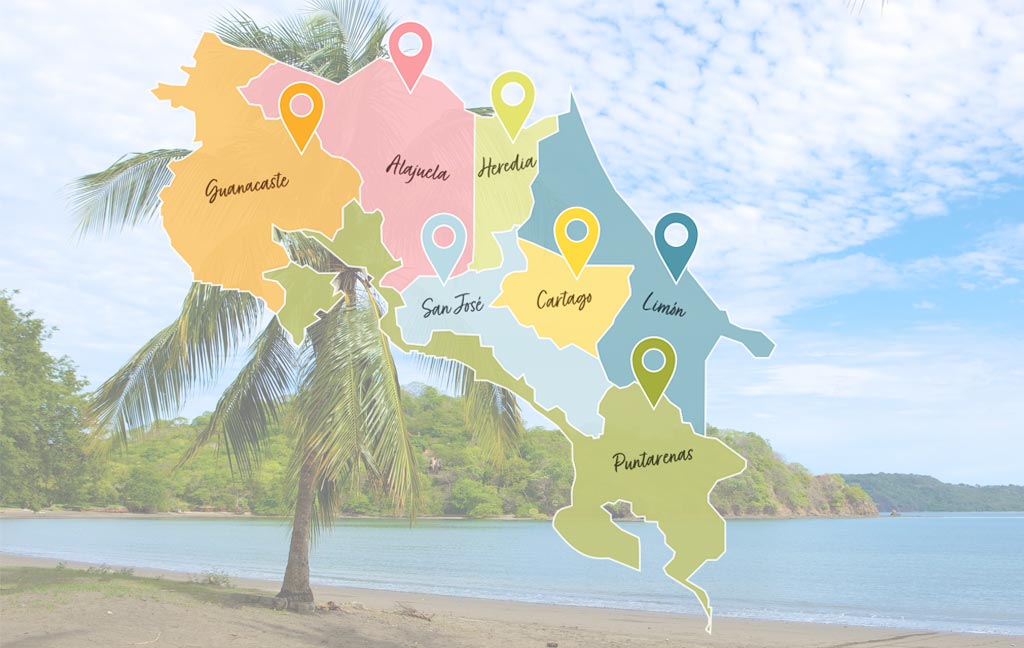The 7 Provinces of Costa Rica –A Brief Introduction

Explore the fascinating beauty and rich diversity of Costa Rica's 7 provinces and immerse yourself in the
immerses us. From the mist-filled mountains in the magical Heredia area to the pristine Pacific beaches of Guanacaste
pristine Pacific beaches in the Guanacaste area, let yourself be enveloped by the natural wonders of this beautiful country.
Introduction:
Costa Rica, a truly tropical country in Central America, stands out for its landscapes, its flora and fauna and its welcoming flora and fauna and its welcoming hospitality. This beautiful country is made up of seven each with its own special combination of natural wonders, cultural heritage and exciting experiences, cultural heritage and exciting experiences. Venture out to explore the 7 provinces and singers that make up Costa Rica and discover why they call Costa Rica a beautiful paradise.
San José:
San José is the capital of Costa Rica, located in the center of the country, specifically on the intervolcanic plateau of the Central Valley. Culturally, it is considered almost entirely influenced by Europe, thanks to immigration, especially Spanish and Italian, and the adoption of French and Belgian trends since the late nineteenth century. This reflects the fact that Costa Rica has been, for many years, an attractive destination for emigrating families, making the country an attractive place to live today.
Alajuela:
Alajuela is the second province of Costa Rica, located in the north of the country. To the north it borders Nicaragua, to the west with Guanacaste, to the southwest with Puntarenas, to the south with San José and to the east with Heredia. The Juan Santamaría International Airport is located there, just 20 minutes from San José, the capital of Costa Rica. Currently, from the airport you can see the imposing Poás volcano when landing. In addition, the flora and fauna of the mountains of Alajuela are impressive, which attracts many tourists interested in birdwatching that have an incredible diversity.
Cartago:
Historically, Cartago was the first capital of Costa Rica during the viceregal period, from 1563 to 1824. It was the residence of the Spanish governors from its founding until the independence of the Central American provinces in 1821 and was home to the country's first government boards. Today, many Catholic believers visit the Basilica of Our Lady of the Angels in Cartago, where every year a pilgrimage takes place that attracts millions of people from both the national territory and abroad, deeply touching all of Costa Rica.
Heredia:
Heredia, known as the province of flowers, is the fourth province of the country and is located in the north-central part. It is bordered to the north by Nicaragua, to the east by the province of Limón, to the south by the province of San José and to the west by the province of Alajuela. It is one of the most mountainous provinces, famous for the cultivation of coffee and rich in history. Its beautiful mist-covered mountains offer a natural spectacle, full of biodiversity with an impressive fauna and flora. Heredia is surrounded by springs and rivers, which makes it a very attractive destination for photography lovers interested in capturing the diversity of exotic animals.
Guanacaste:
Guanacaste is the origin of many elements of Costa Rican folklore, including its music and instruments such as the marimba and the quijongo. It has traditional dances such as the punto guanacasteco and a cuisine rich in corn and cattle products. It also has a culture characteristic of the hacienda villages and the countryside. This region has positioned itself as the second, after the Central Valley, with better development expectations. In Guanacaste, towns such as Tamarindo, famous for being a popular surfing destination with a vibrant nightlife, and Nosara, a serene coastal town known for its yoga retreats and sustainable practices, also stand out.
Puntarenas:
Puntarenas stands out as one of the main tourist regions of Costa Rica. Its coasts are adorned with abundant islands, inlets and beaches, in addition to possessing natural treasures of great beauty that make it an ideal tourist destination both nationally and internationally. Due to its strategic location, it is a frequent stopover point for cruise ships. Its territory offers a wide variety of attractions centered on sun and beach, which are perfectly complemented by protected areas, both insular and continental. Other notable towns in the province of Puntarenas include Monteverde, known for its cloud forest reserve, rich in biodiversity and exciting canopy tours, and Dominical, a quiet beach town famous for its world-class surfing spots.
Limón:
Limón is a Caribbean province rich in flora, fauna and history. An example of this is the centrally located Vargas Park, a national symbol that reflects the region's distinctive Afro-Caribbean history and culture. Its inhabitants make you feel at home in this unique province, home to Costa Rica's main port. The beaches of the place, bathed by the waters of the Caribbean, offer an unparalleled experience. Tortuguero is a paradisiacal destination for nature lovers, where it is possible to admire leatherback turtles, an endangered species protected in the country. In addition, you can visit beaches such as Tamarindo and Playa Negra, among many others. Limón is an ideal place to enjoy with the family.
Conclusion:
Costa Rica's seven provinces invite you on an extraordinary journey through their rich history, replete with breathtaking landscapes, diverse flora and fauna, and vibrant cultural heritage. From the bustling streets of San José to the pristine beaches of Guanacaste and the lush rainforests of Limón, each province offers a unique experience of the country. With distinct histories and cultures, whether you are looking for adventure, relaxation, or cultural immersion, Costa Rica has something special for you. Immerse yourself in its natural wonders, enjoy the flavors of its traditional cuisine and feel the warmth of the Costa Rican spirit as you embark on an unforgettable journey through its seven provinces. Plan your visit and discover why Costa Rica is a truly enchanting destination.


